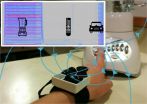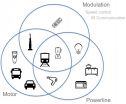(Press-News.org) In today's smart home, technologies can track how much energy a particular appliance like a refrigerator or television or hair dryer is gobbling up. What they don't typically show is which person in the house actually flicked the switch.
A new wearable technology developed at the University of Washington called MagnifiSense can sense what devices and vehicles the user interacts with throughout the day, which can help track that individual's carbon footprint, enable smart home applications or even assist with elder care.
In a study to be presented this week at the 2015 ACM International Joint Conference on Pervasive and Ubiquitous Computing (UbiComp 2015), MagnifiSense correctly classified 94 percent of users' interactions with 12 common devices after a quick one-time calibration, including microwaves, blenders, remote controls, electric toothbrushes, laptops, light dimmers, and even cars and buses. Even without the calibration, MagnifiSense was still correct 83 percent of the time.
The sensor worn on the wrist uses unique electromagnetic radiation signatures generated by electrical components or motors in those devices to pinpoint when its wearer flicks a light switch, turns on a stove or even boards a train.
"It's another way to log what you're interacting with so at the end of the day or month you can see how much energy you used," said Shwetak Patel, Washington Research Foundation Endowed Professor of Computer Science & Engineering and Electrical Engineering, who directs the UW Ubicomp Lab.
"Right now, we can know that lights are 20 percent of your energy use. With this, we divvy it up and say who consumed that energy," said Patel.
In a 24-hour test in which a single user did everything from read on a laptop to cook dinner and take a bus ride, the system correctly identified 25 out of 29 interactions with various devices and vehicles.
MagnifiSense also has potential for other smart home applications, such as recognizing a user's preference for interacting with an appliance or device. By sensing whether an adult or child is turning on a television or tablet, for instance, a system could automatically display their favorite programs or tailor the device with appropriate selections.
In assisted living settings or nursing homes, the wearable sensor could help keep track of how efficiently elderly people are going about everyday tasks such as cooking or grooming. It could also detect when a stove has been left on for a long period of time and help alert someone to that danger.
"The nice thing with MagnifiSense is that you don't have to instrument every single appliance in your house, which gets expensive and cumbersome," said lead author Edward Wang, a UW electrical engineering doctoral student. "It can also sense some of the blank spots that other technologies can't, like battery-powered devices."
The team combined three simple, off-the-shelf sensors that use inductors, or coils of wire wound around magnets. Those proved to be the most accurate without being so power-hungry that wearing them would be impractical.
The sensors also capture a broad frequency range that allows the system to differentiate between electromagnetic radiation emanating from the unique combinations of electronic components such as motors, rectifiers and modulators embedded in everyday devices.
"When a blender turns on, for instance, modulators change the current profile of the device and create something similar to a vocal cord pattern," Wang said. "A blender 'sings' quite differently than a hair dryer even though to our ears they sound similar."
The team also developed innovative signal processing and machine learning algorithms to help the system correctly match those patterns with a particular type of device.
One advantage to a wearable option is that anyone concerned about privacy issues can control when they use it, researchers said, or simply take it off.
Next steps include testing MagnifiSense on a wider variety of devices and distinguishing between multiple devices operating in close proximity. In preliminary tests, for instance, MagnifiSense had the most trouble correctly classifying a handful of particular toothbrushes, shavers and cars.
The researchers also plan to work on miniaturizing their proof-of-concept device into something that could be embedded into a watch or band. Based on its investigation, the team believes that with slight improvement to the update rate of magnetic sensors in current smartphones and smartwatches, MagnifiSense could soon be enabled on new devices with a simple software upgrade.
"We think it could be integrated into any wrist-sized product," said Patel. "The next steps are really to look at what other devices we can detect and work on a prototype that's wearable."
INFORMATION:
Co-authors include UW electrical engineering doctoral student Tien-Jui Lee, UW computer science and engineering doctoral students Alex Mariakakis and Mayank Goel, and Sidhant Gupta.
For more information, contact Wang and Patel at magnifisense@cs.washington.edu.
Web version with images posted here: http://www.washington.edu/news/2015/09/08/new-wearable-technology-can-sense-appliance-use-help-track-carbon-footprint/
Irvine, Calif., Sept. 7, 2015 - Astronomers from the University of California, Irvine and Baltimore's Space Telescope Science Institute have generated the most accurate statistical description yet of faint, early galaxies as they existed in the universe 500 million years after the Big Bang.
In a research paper published today in Nature Communications, the team describes its use of a new statistical method to analyze Hubble Space Telescope data captured during lengthy sky surveys. The method enabled the scientists to parse out signals from the noise in Hubble's deep-sky ...
Privately insured pregnant women are less likely to have C-sections when their regular care includes midwives and 24-hour obstetrician coverage, according to a study by researchers at UC San Francisco and Marin General Hospital.
The study published online in Obstetrics & Gynecology, on Sept. 8, compared the number of C-sections among women with private insurance, before and after an overhaul of staff practices at Marin General Hospital.
Prior to April 2011, private patients at this community hospital in Northern California were managed under a conventional model, in ...
BEER-SHEVA, Israel...September 9, 2015 -- Ben-Gurion University of the Negev (BGU) research demonstrates how Jewish mothers' emphasis on the many aspects of well being, fitness and a sense of self-fulfillment helps to counteract the innumerable "ideal" body images seen and heard by their daughters in the mass media.
The new study published in Feminism and Psychology focuses on how Jewish mothers instilled resilience in their daughters to combat body dissatisfaction, which can lead to eating disorders. It included 20 pairs of mothers and adult-age daughters and eight other ...
With an ever increasing number of everyday objects from our homes, workplaces and even from our wardrobes, getting connected to the Internet, known as the 'Internet of Things (IoT), researchers from the University of Southampton have identified easy-to-use techniques to configure IoT objects, to make them more secure and hence help protect them from online attacks.
This increased connectivity brings additional risk. Setting personalised and strong passwords when connecting new devices to the Internet, for example through our home Wi-Fi networks, can mitigate such risks. ...
Liverpool, 9 September 2015 - A new systematic review of animal studies testing a vaccine for tuberculosis raises questions about whether the studies provided sufficient evidence to move into trials of children.
The new vaccine was a virus-expressing antigen 85A (MVA85A) designed to boost the immunity offered by the existing Bacillus Calmette-Guérin (BCG) vaccine which has little protective effect in practice. The review, published today in the International Journal Epidemiology, evaluates the animal evidence that contributed to the decision to conduct human studies. ...
A new regulation adopted by the European Parliament and the Council will allow customs to access information to track the origins and routes of cargo containers arriving in the EU. This new capability will support the fight against customs fraud both at EU and national level. The JRC has been instrumental in the conception and adoption of this legislation by providing the scientific evidence on the importance of analysing electronic records on cargo container traffic.
The EU customs authorities have been long aware that information on the logistics and actual routes of ...
Most people are familiar with the double-helix shape that allows genetic information to be packed into a molecule of human DNA. Less well-known is how all this information - which, if laid end-to-end, would stretch some three meters - is packed into the cellular nucleus. The secret of how this crush of genetic code avoids chaos - remaining untangled, correctly compartmentalized, and available for accurate DNA replication - has recently been revealed.
By tracking and analyzing the movement of fluorescently-tagged genomic regions within the nuclei of live cells, an international ...
In the latest issue of the journal Nature Chemistry researchers led by Dirk Trauner, Professor of Chemical Biology and Genetics at LMU Munich, describe the biomimetic synthesis of epicolactone, a compound which was first isolated from an endophytic fungus. "What we have accomplished is one of the shortest and most elegant total syntheses of a natural product ever reported," says Trauner, as he and his colleagues have indeed succeeded in producing a highly complex molecular structure in a minimal number of steps. "This is actually very close to being an ideal synthesis - ...
Understanding the evolutionary history of organisms is important for myriad reasons. To name a few, information about relationships between species can be used to guide the classification of biodiversity, inform conservation policies aimed at protecting threatened species, aid in tracking the spread of pathogens, and can even play a role in the discovery of new medicines.
Scientists depict the relationships between species with evolutionary trees, also called phylogenies. A phylogeny shows the accumulation of species through time and the relationships between these species, ...
New research led by NYU Langone Medical Center has uncovered why a particular strain of Staphylococcus aureus -- known as HA-MRSA -- becomes more deadly than other variations. These new findings open up possible new pathways to vaccine development against this bacterium, which the Centers for Disease Control and Preventions says accounts for over 10,000 deaths annually, mostly among hospital patients.
In a series of experiments in mice and in human immune cells in the lab, recently published in the journal Nature Communications online Sept. 2, the NYU Langone team found ...


